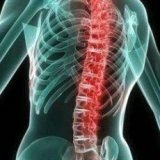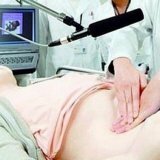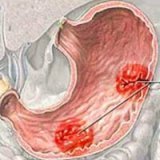Congenital surgical pathology of newborns

- The first hours after birth have passed - if the child has gastroschisis;
- No more than two days - if the child has an embryonic hernia with a narrow base of the defect;
- No more than five to six days - if the child has an embryonic hernia with a wide base of defect;
- It is compulsory when the first or second day of life ends - atresia of the esophagus;
- In the process of reducing pulmonary hypertension - on the fifth - the seventh day of life - diaphragmatic hernia;
- If go second - third day of life - duodenal obstruction;
- In the twelve first hours after birth - small bowel atresia;
- Atresia of the esophagus.
In 95% of cases the esophagus has a blind end at the upper end. The lower part has a communication with the trachea. In this case, a fistulae of tracheoesophageal water forms.
Aspiration syndrome causes the severity of the condition when there is a casting of gastric contents in the pathway of the tracheobronchial. Usually this happens through a fistula or milk with enteral feeding. At this time, there is a profuse foamy discharge from the nose and mouth. It is this secretion that can lead to respiratory failure and aspiration. And time, in this case, is a bad helper.
Timely diagnosis of defects in newborns will be timely. Typically, doctors take swabs from the mouth and nasopharynx, carry out activities associated with the introduction of a nasopharyngeal probe. During the introduction, it bends, simulating this patency. The introduction of air into the syringe allows you to correctly diagnose. Such a surgical pathology does not allow you to try to give a drink and feed the child.
This diagnosis can be confirmed by radiology. A contrast probe will help in this. Only not in the esophagus - aspiration may occur. If this does happen, tracheal intubation will help. Respiratory failure is reduced: IVL.
Intestinal obstruction.
Such congenital surgical pathology of newborns as intestinal obstruction, most often requires urgent surgical treatment. The causes are the digestive system.
High intestinal obstruction( level of the duodenum or the initial part of the jejunum) and low intestinal obstruction should be identified.
High intestinal obstruction.
Already during the first hours of life and during the first day you can observe vomiting in a newborn. More often it is a mixture and bile. Stool - meconium, stomach - sunken, bloating in epigastrium after feeding, disappearing after vomiting.
Sensing is also used for diagnostics.
Enteral feeding is canceled if there is a suspicion of intestinal obstruction. In this case, a nasogastric tube is prescribed.
After a lapse of five days of life, a newborn can be assigned an operative intervention.
Low intestinal obstruction
When the intestines are overgrown with loops, one can observe bloating of the newborn's abdomen. This symptom signals that meconium does not depart. Vomiting appears at the end of the second - third day.
Sensing is used as diagnostics.
Toxicosis and pain syndromes act as factors that determine the severity of the condition. Feeding newborns with such symptoms is prohibited. Mandatory assignment and installation of the probe and immediate therapy.
Atresia of the anus and rectum.
Diagnosis on examination: meconium departs from the fistula from the vagina, with the uncalled isolate low intestinal obstruction.
Assign:
- infusion therapy,
- nasogastric tube,
- cancel enteral feeding.
The operation is done at the end of the first day.
Diaphragmatic hernia.
This is a peculiar transition of the abdominal cavity organs into the thorax. Hypoplasia of the lungs, pulmonary hypertension and cardiovascular failure make the condition worse.
This congenital pathology manifests itself in a sunken abdomen, a barrel shaped asymmetric thorax.
Sensing is used as diagnostics. Nasogastric tube - constantly, an enema for cleaning the intestines, parenteral nutrition.
Only proper transportation of nutrients can give a good prognosis of life.
Embryonic hernia of the umbilical cord( omphalocele).
Internal organs protrude through the defective anterior abdominal wall.
In fifty cases it appears in combination with other pathologies of newborns.
As part of the liver enters the hernial sac, the newborn is exposed to the risk of hypothermia. The rupture of the hernial sac can also occur during childbirth. As a consequence, peritonitis and sepsis may develop. Salvation in this case is the incubator.
Only newborns with small and medium hernias are suitable for surgery. And only if there are no aggravating factors. Having encased this place with sterile napkins, the child is transferred to surgery.
Where the hernia is large, sterilized napkins are applied and immobilized vertically, as well as other necessary therapy.
Gastroschism.
This pathology of newborns is due to intrauterine prolapse of organs through the diaphragm. There is no hernial sac. In this case, the liver is in the abdominal cavity.
Very quickly lost heat and liquid. The beginning of life the newborn should spend in a cuvete. The organs are covered with napkins. The probe is mandatory. Intrauterine hypotrophy, hypoprotoinemia, hypoplasm, postnatal pain syndrome, infection - all this increases the severity of the condition, and the first minutes of a child's life are conditioned by preoperative preparation.
Bladder exstrophy.
Defective lower part of anterior abdominal wall.
Operation is urgent. It is carried out during the first two days of the child's life.
These measures are necessary for children whose birth accompanies the diagnosis: "Congenital surgical pathology of newborns."



